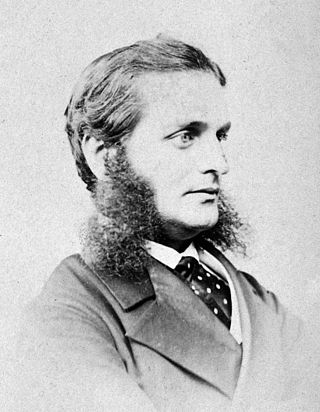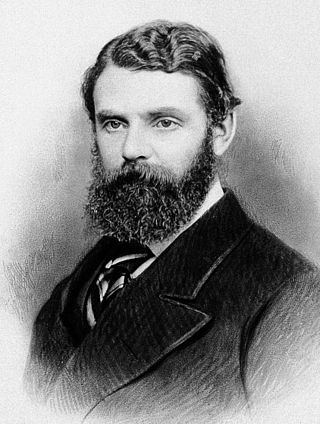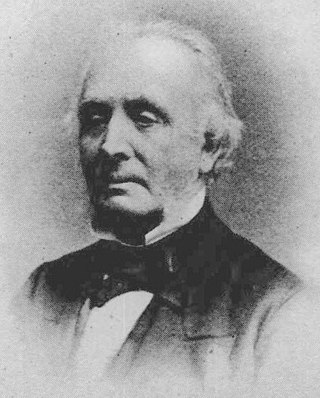Related Research Articles

In Britain, a workhouse was an institution where those unable to support themselves financially were offered accommodation and employment. The earliest known use of the term workhouse is from 1631, in an account by the mayor of Abingdon reporting that "we have erected wthn [sic] our borough a workhouse to set poorer people to work".

Ernest Abraham Hart was an English medical journalist. He was the editor of The British Medical Journal.

Francis Edmund Anstie was an English doctor, medical author and journalist. He was the first editor of medical journal The Practitioner, established in 1868. He is notable for proposing Anstie's limit, an amount of alcohol that could be consumed daily with no ill effects.

Hammersmith Hospital, formerly the Military Orthopaedic Hospital, and later the Special Surgical Hospital, is a major teaching hospital in White City, West London. It is part of Imperial College Healthcare NHS Trust in the London Borough of Hammersmith and Fulham, and is associated with the Imperial College Faculty of Medicine. Confusingly the hospital is not in Hammersmith but is located in White City adjacent to Wormwood Scrubs and East Acton.

Selly Oak Hospital was situated in the Selly Oak area of Birmingham, England. Previously managed by the University Hospitals Birmingham NHS Foundation Trust, the hospital closed in 2011.

Thomas Michael Greenhow MD MRCS FRCS was an English surgeon and epidemiologist.
The Metropolitan Asylums Board (MAB) was established under Poor Law legislation to deal with London's sick and poor. It was established by the Metropolitan Poor Act 1867 and dissolved in 1930, when its functions were transferred to the London County Council.

St Olave's Hospital was a general hospital serving the Rotherhithe area of London until its closure in 1985.

Nottingham City Hospital is a large hospital located in Nottingham, England. It occupies a large 90-acre (360,000 m2) site on the ring road to the North of the city centre. It is composed of many buildings, most of which are joined by long corridors. Buildings include a leisure club, a Maggies Centre for people with cancer, and a patient hotel. It is managed by the Nottingham University Hospitals NHS Trust.

Agnes Elizabeth Jones of Fahan, County Donegal, Ireland became the first trained Nursing Superintendent of Liverpool Workhouse Infirmary. She gave all her time and energy to her patients and died at the age of 35 from typhus fever. Florence Nightingale said of Agnes Elizabeth Jones, ‘She overworked as others underwork. I looked upon hers as one of the most valuable lives in England.’

University Hospital Lewisham is a teaching hospital run by Lewisham and Greenwich NHS Trust and serving the London Borough of Lewisham. It is now affiliated with King's College London and forms part of the King's Health Partners academic health science centre. It is situated on Lewisham High Street between Lewisham and Catford.

Louisa Twining was an English philanthropic worker who devoted herself to issues and tasks related to the English Poor Law. Her family owned the famous Twinings tea business on the Strand, which is a renowned business nowadays. In the early part of her adult life, Louisa was an artist and art historian. In her 30s she started work on projects related to the Poor Law which she followed for the rest of her life. She helped to establish a home for workhouse girls and a number of societies and associations related to workhouses and infirmaries. She also served as a Poor Law guardian and was president of the Women's Local Government Society.

The Cleveland Street Workhouse is a Georgian property in Cleveland Street, Marylebone, built between 1775 and 1778 for the care of the sick and poor of the parish of St Paul Covent Garden under the Old Poor Law. From 1836, it became the workhouse of the Strand Union of parishes. The building remained in operation until 2005 after witnessing the complex evolution of the healthcare system in England. After functioning as a workhouse, the building became a workhouse infirmary before being acquired by the Middlesex Hospital and finally falling under the NHS. In the last century it was known as the Middlesex Hospital Annexe and the Outpatient Department. It closed to the public in 2005 and it has since been vacated. On 14 March 2011 the entire building became Grade II Listed. Development of the site began in 2019 by current owner University College London Hospitals (UCLH) Charity as a mixed-use development including residential, commercial and open space, but construction has been held up by the necessity to remove human remains stemming from the use of the area around the workhouse as a parish burial ground between 1780 and 1853. There has also been controversy about the amount of social housing to be included in the development.

Joseph Rogers (1821–1889) was an English physician and campaigning medical officer.

Emily Winifred Dickson was an Irish medical doctor who was the first female fellow of the Royal College of Surgeons in Ireland. She was also the first female fellow of any of the Royal Colleges of Surgery in Great Britain and Ireland.

Brownlow Hill infirmary was a large workhouse infirmary in Liverpool, notable for its role in advancing training of nurses. The workhouse was demolished in 1931, and the site is now occupied by Liverpool's Catholic cathedral.

The Poor Law Amendment Act 1867 was an Act of the Parliament of the United Kingdom, sponsored by Gathorne Gathorne-Hardy, 1st Earl of Cranbrook and supported by Henry Herbert, 4th Earl of Carnarvon, Florence Nightingale and the Association for the Improvement of the Infirmaries of London Workhouses.
Workhouse infirmaries were established in the nineteenth century in England. They developed from the Workhouse and were run under the Poor law regime.
Uvedale Corbett Jr. was a Poor Law inspector.

Alnwick Infirmary is a community hospital in Alnwick, Northumberland, England. It is managed by Northumbria Healthcare NHS Foundation Trust.
References
- ↑ Ayers, Gwendoline (1971). England's First State Hospitals. London: Wellcome Institute of the History of Medicine. Retrieved 19 March 2017.
- ↑ McConville, Sean (1995). English Local Prisons, 1860-1900: Next Only to Death. Psychology Press. pp. 30–31. ISBN 0415032954 . Retrieved 19 March 2017.
- ↑ Rivett, Geoffrey. "The Poor Law Infirmaries". NHS History. Retrieved 11 June 2017.
- ↑ "Dickens, Rogers and Miss Nightingale". Kings College. Retrieved 8 November 2022.
- ↑ "An account of the condition of the infirmaries of London workhouse". Hathi Trust. Retrieved 8 November 2022.